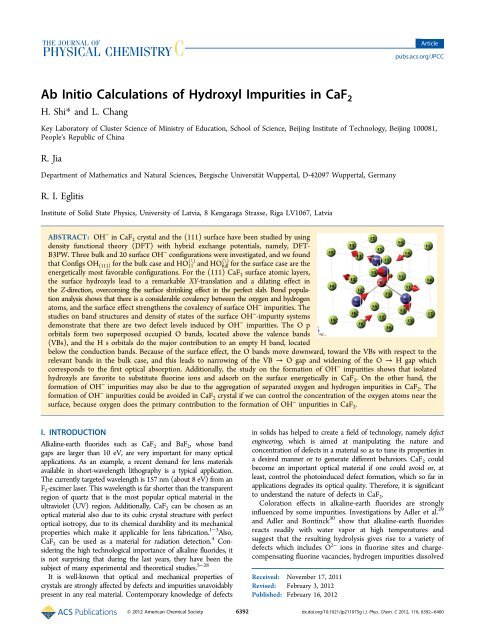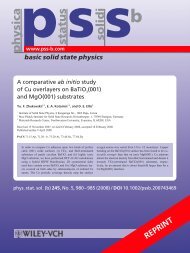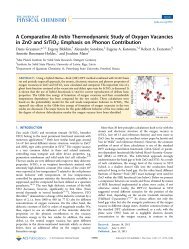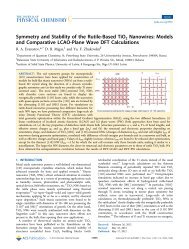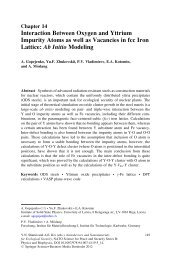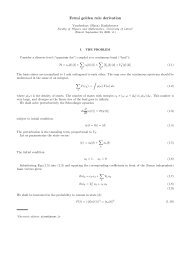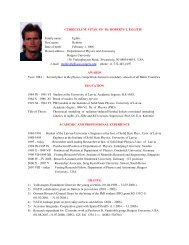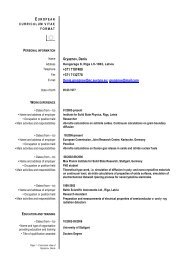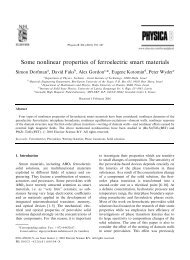Ab Initio Calculations of Hydroxyl Impurities in CaF2
Ab Initio Calculations of Hydroxyl Impurities in CaF2
Ab Initio Calculations of Hydroxyl Impurities in CaF2
You also want an ePaper? Increase the reach of your titles
YUMPU automatically turns print PDFs into web optimized ePapers that Google loves.
Articlepubs.acs.org/JPCC<strong>Ab</strong> <strong>Initio</strong> <strong>Calculations</strong> <strong>of</strong> <strong>Hydroxyl</strong> <strong>Impurities</strong> <strong>in</strong> CaF 2H. Shi* and L. ChangKey Laboratory <strong>of</strong> Cluster Science <strong>of</strong> M<strong>in</strong>istry <strong>of</strong> Education, School <strong>of</strong> Science, Beij<strong>in</strong>g Institute <strong>of</strong> Technology, Beij<strong>in</strong>g 100081,People's Republic <strong>of</strong> Ch<strong>in</strong>aR. JiaDepartment <strong>of</strong> Mathematics and Natural Sciences, Bergische Universitaẗ Wuppertal, D-42097 Wuppertal, GermanyR. I. EglitisInstitute <strong>of</strong> Solid State Physics, University <strong>of</strong> Latvia, 8 Kengaraga Strasse, Riga LV1067, LatviaABSTRACT: OH − <strong>in</strong> CaF 2 crystal and the (111) surface have been studied by us<strong>in</strong>gdensity functional theory (DFT) with hybrid exchange potentials, namely, DFT-B3PW. Three bulk and 20 surface OH − configurations were <strong>in</strong>vestigated, and we foundthat Configs OH (111) for the bulk case and HO (\) 11 and HO (\) full for the surface case are theenergetically most favorable configurations. For the (111) CaF 2 surface atomic layers,the surface hydroxyls lead to a remarkable XY-translation and a dilat<strong>in</strong>g effect <strong>in</strong>the Z-direction, overcom<strong>in</strong>g the surface shr<strong>in</strong>k<strong>in</strong>g effect <strong>in</strong> the perfect slab. Bond populationanalysis shows that there is a considerable covalency between the oxygen and hydrogenatoms, and the surface effect strengthens the covalency <strong>of</strong> surface OH − impurities. Thestudies on band structures and density <strong>of</strong> states <strong>of</strong> the surface OH − -impurity systemsdemonstrate that there are two defect levels <strong>in</strong>duced by OH − impurities. The O porbitals form two superposed occupied O bands, located above the valence bands(VBs), and the H s orbitals do the major contribution to an empty H band, locatedbelow the conduction bands. Because <strong>of</strong> the surface effect, the O bands move downward, toward the VBs with respect to therelevant bands <strong>in</strong> the bulk case, and this leads to narrow<strong>in</strong>g <strong>of</strong> the VB → O gap and widen<strong>in</strong>g <strong>of</strong> the O → H gap whichcorresponds to the first optical absorption. Additionally, the study on the formation <strong>of</strong> OH − impurities shows that isolatedhydroxyls are favorite to substitute fluor<strong>in</strong>e ions and adsorb on the surface energetically <strong>in</strong> CaF 2 . On the other hand, theformation <strong>of</strong> OH − impurities may also be due to the aggregation <strong>of</strong> separated oxygen and hydrogen impurities <strong>in</strong> CaF 2 . Theformation <strong>of</strong> OH − impurities could be avoided <strong>in</strong> CaF 2 crystal if we can control the concentration <strong>of</strong> the oxygen atoms near thesurface, because oxygen does the primary contribution to the formation <strong>of</strong> OH − impurities <strong>in</strong> CaF 2 .I. INTRODUCTIONAlkal<strong>in</strong>e-earth fluorides such as CaF 2 and BaF 2 , whose bandgaps are larger than 10 eV, are very important for many opticalapplications. As an example, a recent demand for lens materialsavailable <strong>in</strong> short-wavelength lithography is a typical application.The currently targeted wavelength is 157 nm (about 8 eV) from anF 2 -excimer laser. This wavelength is far shorter than the transparentregion <strong>of</strong> quartz that is the most popular optical material <strong>in</strong> theultraviolet (UV) region. Additionally, CaF 2 can be chosen as anoptical material also due to its cubic crystal structure with perfectoptical isotropy, due to its chemical durability and its mechanicalproperties which make it applicable for lens fabrication. 1−3 Also,CaF 2 can be used as a material for radiation detection. 4 Consider<strong>in</strong>gthe high technological importance <strong>of</strong> alkal<strong>in</strong>e fluorides, itis not surpris<strong>in</strong>g that dur<strong>in</strong>g the last years, they have been thesubject <strong>of</strong> many experimental and theoretical studies. 5−28It is well-known that optical and mechanical properties <strong>of</strong>crystals are strongly affected by defects and impurities unavoidablypresent <strong>in</strong> any real material. Contemporary knowledge <strong>of</strong> defects<strong>in</strong> solids has helped to create a field <strong>of</strong> technology, namely defecteng<strong>in</strong>eer<strong>in</strong>g, which is aimed at manipulat<strong>in</strong>g the nature andconcentration <strong>of</strong> defects <strong>in</strong> a material so as to tune its properties <strong>in</strong>a desired manner or to generate different behaviors. CaF 2 couldbecome an important optical material if one could avoid or, atleast, control the photo<strong>in</strong>duced defect formation, which so far <strong>in</strong>applications degrades its optical quality. Therefore, it is significantto understand the nature <strong>of</strong> defects <strong>in</strong> CaF 2 .Coloration effects <strong>in</strong> alkal<strong>in</strong>e-earth fluorides are strongly<strong>in</strong>fluenced by some impurities. Investigations by Adler et al. 29and Adler and Bont<strong>in</strong>ck 30 show that alkal<strong>in</strong>e-earth fluoridesreacts readily with water vapor at high temperatures andsuggest that the result<strong>in</strong>g hydrolysis gives rise to a variety <strong>of</strong>defects which <strong>in</strong>cludes O 2− ions <strong>in</strong> fluor<strong>in</strong>e sites and chargecompensat<strong>in</strong>gfluor<strong>in</strong>e vacancies, hydrogen impurities dissolvedReceived: November 17, 2011Revised: February 3, 2012Published: February 16, 2012© 2012 American Chemical Society 6392 dx.doi.org/10.1021/jp211075g | J. Phys. Chem. C 2012, 116, 6392−6400
The Journal <strong>of</strong> Physical Chemistry CArticleThe calculated atomic displacements <strong>of</strong> the OH − andsurround<strong>in</strong>g atoms for Config OH (111) are listed <strong>in</strong> Table 1.Table 1. Atomic Relaxations (D (% a 0 ), as a Percentage <strong>of</strong>the Lattice Constant, 5.50 Å) and Effective Charges (Q(e))<strong>of</strong> the OH − and Surround<strong>in</strong>g Atoms <strong>in</strong> the CaF 2 96-AtomSupercell for Config OH (111)aatoms (shell) no. D (% a 0 ) Q (e) ΔQ (e)O 1 1.93 −0.997 −H 1 − +0.275 −Ca1 3 1.10 +1.772 −0.031Ca2 1 0.73 +1.799 −0.004F1 3 0.34 −0.913 −0.011F2 3 0.32 −0.915 −0.013F3 6 0.33 −0.901 +0.001F4 3 0.28 −0.903 −0.001F6 3 0.18 −0.900 +0.002a ΔQ(e) is the charge difference between the defective and perfectcrystals (Q Ca = +1.803 e, Q F = −0.902 e <strong>in</strong> perfect CaF 2 ). The shelllabels have been def<strong>in</strong>ed <strong>in</strong> Figure 1.The three Ca1 atoms are repulsed from the OH − by around1.10% <strong>of</strong> a 0 , and the one Ca2 moves toward the OH − byaround 0.73% <strong>of</strong> a 0 . The OH − −Ca1 and OH − −Ca2 distancesboth <strong>in</strong>crease by around 0.25% and 1.20% <strong>of</strong> a 0 , respectively,implicat<strong>in</strong>g a repulsion <strong>of</strong> the OH − impurity to the neighborcalcium atoms. F<strong>in</strong>ally, the relaxations <strong>of</strong> neighbor fluor<strong>in</strong>eatoms are slight and less than 0.4% <strong>of</strong> a 0 .Table 1 also presents the effective charges <strong>of</strong> the OH − andsurround<strong>in</strong>g atoms for Config OH (111) . The total charge <strong>of</strong> theOH − , i.e., the sum <strong>of</strong> the O and H charges, is −0.722 e, be<strong>in</strong>gmuch smaller than the charge <strong>of</strong> the substituted fluor<strong>in</strong>e atom(−0.902 e) by 0.180 e. Around 0.097 and 0.072 e localized onthe four nearest Ca and six second-nearest F, respectively,transfer <strong>in</strong>ward to the OH − . For Configs HO (111) and OH (100) ,the effective charges <strong>of</strong> OH − are −0.713 and −0.737 e, be<strong>in</strong>gclose to the correspond<strong>in</strong>g value <strong>of</strong> Config OH (111) . We alsocalculated the OH − charges <strong>in</strong> Ca(OH) 2 and Ba(OH) 2 crystals.The results show that the total effective charges <strong>of</strong> OH − <strong>in</strong>Ca(OH) 2 and Ba(OH) 2 are equal to −0.781 and −0.825 e,respectively. The OH − charge <strong>in</strong> Ca(OH) 2 is larger than OH −as impurities <strong>in</strong> CaF 2 crystal by around 0.4−0.7 e , and thisphenomenon can be expla<strong>in</strong>ed by the fact that fluor<strong>in</strong>e has astronger oxidative property than that <strong>of</strong> OH − . It is well-knownthat the hydroxyl has a considerable covalency between theoxygen and hydrogen, which is also demonstrated by our bondpopulation calculations for the OH − −CaF 2 systems. Thepresence <strong>of</strong> the covalency <strong>of</strong> OH − <strong>in</strong> CaF 2 is also clearlyshown <strong>in</strong> the charge density map (see Figure 2). The covalentbonds between the oxygen and hydrogen atoms are 486, 508,and 536 me for Configs OH (111) , HO (111) , and OH (100) ,respectively. Compared with the covalent bonds <strong>in</strong> Ca(OH) 2(458 me) and Ba(OH) 2 (434 me) crystals, the covalency <strong>of</strong> theOH − impurities <strong>in</strong> CaF 2 is stronger than that <strong>in</strong> the hydroxidecrystals. Here, we can conclude that OH − as an atomic grouphas a steady geometrical structure <strong>in</strong>stead <strong>of</strong> electronicproperties <strong>in</strong> different materials.Alkal<strong>in</strong>e-earth fluorides with defects degrade their opticalquality and exhibit optical absorption. Our calculations on thedefect levels <strong>in</strong>duced between the valence bands (VBs) andconduction bands (CBs) suggest a possible mechanism for theoptical absorption. In the one-electron approximation scheme,Figure 2. Electron density contours <strong>in</strong> CaF 2 with OH − from the (110)side view, be<strong>in</strong>g from 0 to 0.4 e/bohr 3 with a l<strong>in</strong>ear <strong>in</strong>crement <strong>of</strong> 0.01e/bohr 3 .the experimentally observed optical absorption could be due toan electron transition from the ground state to the empty band<strong>in</strong>duced by the OH − impurities. Our calculated band structureregard<strong>in</strong>g the OH − -impurity system <strong>of</strong> Config OH (111) is shown<strong>in</strong> Figure 3, and the optical band gaps for Configs OH (111) ,Figure 3. Calculated B3PW band structure for the 96-atom supercellmodel<strong>in</strong>g the OH − impurity <strong>in</strong> CaF 2 for Config OH (111) .HO (111) and OH (100) are collected <strong>in</strong> Table 2. The optical bandgaps between the VBs and CBs for the CaF 2 96-atom supercellTable 2. Direct Optical Band Gaps (eV) (Γ → Γ) <strong>of</strong> theOH − -Impurity Systems for Configs OH (111) ,HO (111) , andOH (100)gaps OH (111) HO (111) OH (100)O → H 9.04 8.99 9.04O → CB 9.74 9.78 10.24VB → H 10.47 10.52 10.65VB → CB 11.17 11.32 11.85conta<strong>in</strong><strong>in</strong>g a OH − at the Γ po<strong>in</strong>t are 11.17, 11.32, and 11.85 eVfor Configs OH (111) ,HO (111) , and OH (100) , respectively, be<strong>in</strong>gmuch larger than the relevant gap <strong>of</strong> the perfect CaF 2 crystal(10.96 eV). It is implied that the OH − impurities widen theVB−CB gap, especially for Config OH (100) . For Config OH (111) ,the empty defect level <strong>in</strong>duced by OH − impurities is located0.70 eV below the bottom <strong>of</strong> the CB at the Γ po<strong>in</strong>t (see Figure 3).The occupied defect levels, conta<strong>in</strong><strong>in</strong>g two superposed bands6394dx.doi.org/10.1021/jp211075g | J. Phys. Chem. C 2012, 116, 6392−6400
The Journal <strong>of</strong> Physical Chemistry C(the gap is less than 0.01 eV), <strong>in</strong>duced by OH − impurities, arelocated 1.43 eV above the VB top at the Γ po<strong>in</strong>t. S<strong>in</strong>ce hydroxylhas weaker oxidative property than that <strong>of</strong> fluor<strong>in</strong>e, the hydroxyb<strong>in</strong>d<strong>in</strong>g force to the outer-shell electrons is smaller, lead<strong>in</strong>g tothe occupied OH − bands shift<strong>in</strong>g upward with respect to theVB top, ma<strong>in</strong>ly consist<strong>in</strong>g <strong>of</strong> F outer p orbitals. From Figure 3and Table 2, we conclude that the first optical absorption,correspond<strong>in</strong>g to an electron transition from the occupied OH −bands to the empty OH − band, should be centered around9.04 eV, be<strong>in</strong>g much larger than the relevant value <strong>of</strong> 4.24 eVfor CaF 2 conta<strong>in</strong><strong>in</strong>g F centers (an electron trapped <strong>in</strong> thefluor<strong>in</strong>e vacancy). 22 It is because the trapped electron <strong>in</strong> the Fcenter is more delocalized than the valence electron <strong>of</strong>hydroxyl. Unlike the (111)-oriented configurations, for ConfigOH (100) , the two occupied OH − bands separate slightly and thegap is around 0.05 eV.To further study the electronic structure and electrontransitions <strong>in</strong> a OH − -impurity system, we calculated the density<strong>of</strong> states (DOS) <strong>of</strong> the OH (111) system, as we can see <strong>in</strong> Figure 4.Articlecorrespond<strong>in</strong>g to the substitutional OH − impurity located atthe No. 1, 3, 4, and 6 fluor<strong>in</strong>e sublayers, respectively, as we cansee <strong>in</strong> Figure 5. As discussed before, hydroxyls orient the (111)Figure 5. Schematic sketch <strong>of</strong> the (111) slab conta<strong>in</strong><strong>in</strong>g OH −impurities. The big and small circles denote oxygen and hydrogenatoms, respectively.Figure 4. Total and partial density <strong>of</strong> states (DOS) for the OH −impurities (Config OH (111) ) <strong>in</strong> the CaF 2 crystal.Accord<strong>in</strong>g to our calculation, the O p orbitals form the twosuperposed occupied OH − bands, named O bands, and the Hs orbitals do the major contribution to the empty defect band(so-called H band) below the CB bottom. Unlike the occupiedO bands with a very sharp peak <strong>in</strong> the DOS figure, the DOS <strong>of</strong>the unoccupied H band is diffused and very close to the CB.Additionally, the O p orbitals also make some contribution to theVB top, as we can see Figure 4, which ma<strong>in</strong>ly consists <strong>of</strong> F porbitals <strong>in</strong> perfect CaF 2 crystal.B. OH − <strong>Impurities</strong> <strong>in</strong> the CaF 2 Surface. As an extension<strong>of</strong> previous studies on hydroxyl impurities <strong>in</strong> CaF 2 bulks, weperformed calculations for surface OH − impurities. For a (111)slab <strong>of</strong> CaF 2 , there are three sublayers <strong>in</strong> each F−Ca−F layerfrom the side view, and OH − impurities could be only locatedat the upper and lower fluor<strong>in</strong>e sublayers. So, a OH − at onefluor<strong>in</strong>e sublayer has two configurations correspond<strong>in</strong>g to thecases <strong>of</strong> O above H and H above O, labeled OH and HO,respectively, <strong>in</strong> this paper. We calculated eight differentconfigurations <strong>of</strong> the surface OH − impurities, named ConfigOH 11 , HO 11 , OH 12 , HO 12 , OH 21 , HO 21 , OH 22 , and HO 22 ,6395direction <strong>in</strong> CaF 2 bulks. However, we could not confirmwhether the OH − orients also along the (111) direction forsurface OH − -impurity systems. Therefore, we additionallysimulated the eight configurations mentioned above, butwhose <strong>in</strong>itial guessed orientations are not along the (111)axis accurately, <strong>in</strong> which some configurations do not convergeto the (111) direction after geometrical relaxations via a search<strong>of</strong> the m<strong>in</strong>imum total energy, <strong>in</strong>dicat<strong>in</strong>g that the (111)-orientedOH − is not the most stable configuration for surface OH − -impurity systems. We add the superscript (|) or (\) to expressthe (111)-oriented and (111)-unoriented OH − impurities,(|)respectively, such as Configs OH 11 and OH (\) 11 , etc. Ourcalculated results show that the energetically most favorableconfiguration for the surface OH − impurity is Config HO (\) 11 ,<strong>in</strong>which the angle between the OH − axis and the (111) directionis around 3.2°. Table 3 lists the relative energies <strong>of</strong> ConfigTable 3. Total Energies (eV) <strong>of</strong> All the Surface OH − -(\)aImpurity Configurations with Respect to Config HO 11(\) (|)sublayer HO OH HO OH11 0.00 +0.62 +0.09 +0.7012 +0.62 +0.73 +0.70 +1.0621 +0.62 +0.64 +0.95 +0.8222 +0.63 +0.76 +0.70 +1.14a (|) and (\) express the (111)-oriented and (111)-unoriented OH − ,respectively.HO (\) 11 for other configurations. It implicates a trend <strong>of</strong> OH −impurities locat<strong>in</strong>g near the surface. From Table 3, we foundthat most <strong>of</strong> Configs HO have lower energies with respect tothe correspond<strong>in</strong>g Configs OH, <strong>in</strong>dicat<strong>in</strong>g a preference <strong>of</strong> thehydrogen atom locat<strong>in</strong>g above the oxygen atom for the surfaceOH − -impurity systems, and the (111)-unoriented Configs aredx.doi.org/10.1021/jp211075g | J. Phys. Chem. C 2012, 116, 6392−6400
The Journal <strong>of</strong> Physical Chemistry CArticlethe more energetically favorable configurations with respect tothe correspond<strong>in</strong>g (111)-oriented Configs. Additionally, wealso calculated the (111) CaF 2 slabs full covered by OH − . Forthe full-covered slabs, hydroxyls can only replace the surfacefluor<strong>in</strong>e sublayer, so we may classify the full-covered slabs <strong>in</strong>t<strong>of</strong>our configurations, i.e., HO (|) full ,HO (\) full ,OH (|) full , and OH (\) full . Ourcalculated results demonstrate that the most stable full-coveredconfiguration is Config HO (\) full , <strong>in</strong> which the deviation angleequals around 2.2°, and the total energies <strong>of</strong> Configs HO (|) full ,OH (|) full , and OH (\) full are larger than that <strong>of</strong> Config HO (\) full by 0.06,0.63, and 0.58 eV, respectively. So, we can conclude that for thefull-covered slabs, hydrogen atoms prefer to locate aboveoxygen atoms obliquely. Configs HO (\) 11 and HO (\) full are morestable than other surface OH − systems; therefore, we ma<strong>in</strong>lyfocus our current discussion on these two Configs.The geometrical structures <strong>of</strong> the surface OH − are calculatedand depicted <strong>in</strong> Table 4. Accord<strong>in</strong>g to our studies on bulkTable 4. Geometrical Properties <strong>of</strong> the Surface OH −<strong>Impurities</strong> a for all Configs(\) (|)sublayer HO OH HO OH11 0.96(3.2°) 0.97(28°) 0.97 0.9812 0.97(5.3°) 0.97(58.1°) 0.97 0.9621 0.97(65.0°) 0.96(4.8°) 0.96 0.9722 0.97(5.0°) 0.96(57.9°) 0.97 0.95full 0.96(2.2°) 0.97(2.5°) 0.97 0.98a OH − length (Å) and deviation angle shown <strong>in</strong> brackets.OH − -impurity systems, the lengths <strong>of</strong> OH − <strong>in</strong> CaF 2 and BaF 2 ,as well as <strong>in</strong> H 2 O, Ca(OH) 2 , and Ba(OH) 2 , are all around0.96−0.97 Å, <strong>in</strong>dicat<strong>in</strong>g that the OH − as a diatomic group has asteady geometrical structure. Our calculated CaF 2 surface OH − -impurity lengths for all the configurations are around 0.96−0.98 Å,as we can see <strong>in</strong> Table 4. It is implied that the surface effect onthe length <strong>of</strong> surface hydroxyls is not remarkable. From Table4, we found that some Configs, such as OH (\) 12 ,HO (\) 21 , andOH (\) 22 , have very big deviation angles (around 60°), and theorientations <strong>of</strong> other Configs approach the (111) direction. Inan ideal cubic CaF 2 bulk, the angle between the (111) and(100) axes is 54.7°, be<strong>in</strong>g close to those big obliquities <strong>of</strong>around 60°. Therefore, we can consider these Configs with bigdeviation angles as Config OH (100) , namely, the (100)-orientedconfiguration <strong>in</strong> the bulk case, locat<strong>in</strong>g near the (111) surface.It is implied that despite the (111)-oriented OH − be<strong>in</strong>genergetically more favorable <strong>in</strong> CaF 2 bulk, hydroxyls located atsome specific fluor<strong>in</strong>e sublayers near the surface prefer the(100) orientation. Here, we can classify the eight (111)-unorientedconfigurations <strong>in</strong>to three OH − types, i.e., OH (111) ,HO (111) ,andOH (100) <strong>in</strong> the bulk case. Configs OH (\) 11 ,HO (\) 12 ,OH (\) (\)21 ,andHO 22belong to the OH (111) type, Config HO (\) 11 belongs to the HO (111)type, and Configs OH (\) 12 , HO (\) (\)21 , and OH 22 belongs to theOH (100) type. From Tables 3 and 4 and this classification, we canconclude that OH − impurities with HO (111) ,OH (111) ,OH (100) ,andOH (111) configurations prefer to locate at the No.1, 3, 4, and 6fluor<strong>in</strong>e sublayers, respectively.The relaxations <strong>of</strong> atoms surround<strong>in</strong>g the surface OH −impurity are shown <strong>in</strong> Figure 6 and Table 5. For ConfigHO (\) 11 , all the atoms near the surface shift toward the positiveY-axis from the top view, as we can see Figure 6. The oxygenand the six nearest fluor<strong>in</strong>e atoms, i.e., F1, F2, and F3, on theupper sublayer <strong>of</strong> the first layer have considerable XY-shifts6396Figure 6. Top view <strong>of</strong> the surface OH − -impurity nearest-neighborgeometry with an <strong>in</strong>dication <strong>of</strong> relaxation shifts for Config HO (\) 11 . Thedirections <strong>of</strong> atomic displacements <strong>in</strong> the XY-plane are shown witharrows. The fluor<strong>in</strong>e and calcium atoms <strong>in</strong> different shells are labeled.The upper and lower panels denote the first and second layers <strong>of</strong> the(111) CaF 2 slab, respectively.over 2% <strong>of</strong> a 0 , the XY-displacements <strong>of</strong> fluor<strong>in</strong>e atoms locatedat the lower sublayer <strong>of</strong> the first layer and the upper sublayer <strong>of</strong>the second layer are around 1−2% <strong>of</strong> a 0 , and the XYtranslations<strong>of</strong> the fluor<strong>in</strong>e atoms on the lower sublayer <strong>of</strong> thesecond layer equal 0.7% <strong>of</strong> a 0 approximately. Here, we canconclude that the atomic layers conta<strong>in</strong><strong>in</strong>g surface OH −impurities have a remarkable XY-translation. Because <strong>of</strong> thesurface shr<strong>in</strong>k<strong>in</strong>g effect, the atomic coord<strong>in</strong>ates <strong>of</strong> most <strong>of</strong> thesurface atoms reduce, whereas the oxygen atom shifts outwardfrom the surface by around 2.22% <strong>of</strong> a 0 . Table 5 also lists thedisplacements <strong>of</strong> atoms at the top two layers for Config HO (\) full ,i.e., the full-covered case. Similar to Config HO (\) 11 , the toplayers have an obvious XY-translation with respect to thedeeper layers and the surface OH − layer moves upward byaround 3.32% <strong>of</strong> a 0 , implicat<strong>in</strong>g a dilat<strong>in</strong>g effect <strong>in</strong>duced by fullcover<strong>in</strong>ghydroxyls.Table 6 presents the effective charges <strong>of</strong> the surface OH − forall the (111)-unoriented configurations. The OH − charges formost Configs are larger than the OH − charge <strong>in</strong> the CaF 2 bulk(−0.722 e). Especially for Config HO (\) 11 , the effective charge <strong>of</strong>the surface OH − equals −0.746 e and is larger by around 0.024 e.Because <strong>of</strong> the surface effect, −0.005 e localized on thehydrogen atom transfers <strong>in</strong>ward toward the surface and the oxygenatom attracts −0.028 e from the surround<strong>in</strong>g atoms. We alsocalculated the effective charges <strong>of</strong> atoms surround<strong>in</strong>g the OH −impurity,aswecansee<strong>in</strong>Table5.Thechargedifferences<strong>of</strong>thedeeper fluor<strong>in</strong>e and calcium atoms are negligible, whereas thedx.doi.org/10.1021/jp211075g | J. Phys. Chem. C 2012, 116, 6392−6400
The Journal <strong>of</strong> Physical Chemistry CArticleTable 5. Atomic Relaxations (as a Percentage <strong>of</strong> the Lattice Constant, 5.50 Å) and Effective Charges (Q(e)) <strong>of</strong> the (111) CaF 2Surfaces Conta<strong>in</strong><strong>in</strong>g OH − for Configs HO (\) (\)a11 and HO 11HO 11(\)layer sublayer atoms (no.) XY (% a 0 ) Z (% a 0 ) Q (e) ΔQ (e) atoms XY (% a 0 ) Z (% a 0 ) Q (e) ΔQ (e)no. l 1 0 (1) 1.96 +2.22 −1.025 − O 0.96 +3.32 −1.010 −Fl (2) 2.37 −0.18 −0.895 +0.007F2 (2) 2.19 −0.15 −0.895 +0.007F3 (2) 2.67 −0.32 −0.895 +0.0072 Cal (1) 2.46 −0.52 +1.769 −0.034 Ca 1.01 −0.31 +1.718 −0.085Ca2 (2) 1.69 −0.31 +1.771 −0.032 F 0.67 −0.63 −0.945 −0.0433 F4 (1) 1.32 −0.71 −0.918 −0.016F5 (2) 1.66 −1.00 −0.918 −0.016F6 (1) 1.35 −0.54 −0.906 −0.004F7 (2) 1.52 −0.50 −0.907 −0.005no. 2 1 Fl (1) 1.74 −0.24 −0.900 +0.002 F 0.78 −0.09 −0.902 0F2 (2) 1.67 −0.18 −0.900 +0.002F3 (1) 1.60 −0.01 −0.901 +0.001F4 (2) 1.66 −0.17 −0.900 +0.0022 Cal (1) 1.20 −0.35 +1.801 −0.002 Ca 0.58 −0.27 +1.802 −0.001Ca2 (2) 1.22 −0.45 +1.801 −0.0023 F5 (l) 0.76 −0.47 −0.902 0 F 0.37 −0.33 −0.902 0F6 (2) 0.79 −0.35 −0.901 +0.001F7 (2) 0.78 −0.40 −0.901 +0.001F8 (2) 0.69 −0.33 −0.901 +0.001a Positive signs <strong>in</strong> Z-columns correspond to outward atomic displacements (toward the vacuum). The directions <strong>of</strong> atomic displacements <strong>in</strong> the XYplaneare <strong>in</strong>dicated <strong>in</strong> Figure 6. ΔQ(e) labels the change <strong>in</strong> the effective charge compared to perfect CaF 2 crystal (Q Ca = +1.803 e, Q F = −0.902 e).The symbols <strong>in</strong> atom columns are def<strong>in</strong>ed <strong>in</strong> Figure 6.(\)HO fullTable 6. Effective Charges (e) and Bond Populations (me)<strong>of</strong>Surface OH − <strong>Impurities</strong> for All the (111)-UnorientedConfigurationselectron transfer regard<strong>in</strong>g the first-layer atoms is considerable.Around −0.160 e localized on the fluor<strong>in</strong>e sublayer <strong>of</strong> the firstlayer (<strong>in</strong>clud<strong>in</strong>g the six fluor<strong>in</strong>e atoms and one OH − impurity) isattracted by the three Ca atoms and six F atoms at the second andthird sublayers. Tables 6 and 5 also list the results <strong>of</strong> effectivecharge calculations for the OH − full-covered configurations. TheOH − charge for Config HO (\) full is −0.771 e, be<strong>in</strong>g much larger thanthat <strong>of</strong> the bulk case by 0.049 e, and effective charges <strong>of</strong> −1.010and +0.239 e are localized on the O and H, respectively. Around−0.085 and −0.043 e localized on the surface OH − transfersdownward to the nearest Ca and F, respectively. Additionally, wecompared Config HO (\) full with Ca(OH) 2 for the atomic effectivecharges and geometrical structures. The OH − charge <strong>of</strong> −0.781 e<strong>in</strong> Ca(OH) 2 is close to that <strong>of</strong> Config HO (\) full (−0.771 e). The H−(\)O−Ca angles <strong>in</strong> Ca(OH) 2 (around 118°) and Config HO full(around 113°) are also closed. Therefore, we can consider the fullcover<strong>in</strong>gOH − as a piece <strong>of</strong> (CaOH) + membrane filmed on theCaF 2 surface.Table 6 also lists the bond populations for the surface OH − -impurity and full-covered systems. We found that the OH −covalencies for Configs HO (\) 11 (546 me), OH (\) 12 (544 me), and(\) (540 me) are much stronger than that <strong>of</strong> the bulk case byOH 22HO (\) OH (\)sublayer O H O−H O H O−H11 −1.025 +0.280 +546 −1.003 +0.272 +49012 −1.007 +0.278 +494 −1.032 +0.290 +54421 −1.004 +0.283 +496 −1.004 +0.280 +49822 −1.003 +0.280 +494 −1.023 +0.285 +540full −1.010 +0.239 +512 −1.017 +0.278 +492639760, 58, and 54 me, respectively. The bond populations betweenoxygen and hydrogen for other Configs are all larger than that<strong>of</strong> the bulk OH − impurity. We can conclude here that thesurface effect strengthens the covalency <strong>of</strong> OH − impuritieslocated near the surface. Compared with the covalent bonds <strong>of</strong>hydroxyls <strong>in</strong> Ca(OH) 2 (458 me) and Ba(OH) 2 (434 me)crystals, the covalency <strong>of</strong> surface OH − impurities is also muchstronger. For the OH − full-covered configuration, i.e., Config HO (\) full ,the surface effect on the strengthen<strong>in</strong>g OH − -covalencyis not quite pronounced, whereas the bond populationequals 512 me, still be<strong>in</strong>g much larger than that <strong>in</strong> Ca(OH) 2(458 me). Comb<strong>in</strong><strong>in</strong>g the previous discussion about thegeometrical structures <strong>of</strong> OH − impurities,we<strong>in</strong>dicatethatthe OH − as an atomic group has a steady geometricalstructure <strong>in</strong>stead <strong>of</strong> electronic properties <strong>in</strong> differentmaterials. Also the ma<strong>in</strong> surface effect on the OH − impuritiesis on the electronic structures <strong>in</strong>stead <strong>of</strong> the geometricalstructures.To <strong>in</strong>vestigate the surface effect on the optical band gaps, westudied the band structures <strong>of</strong> the surface OH − -impuritysystems. The theoretical optical band gaps for all the (111)-unoriented configurations are collected <strong>in</strong> Table 7, and theband structure <strong>of</strong> Config HO (\) 11 is shown <strong>in</strong> Figure 7. FromTable 7, we can conclude that the surface effect reduces theVB → CB gaps, which are around 11.1−11.5 eV and smallerthan that <strong>in</strong> the bulk cases (11.17, 11.32, and 11.85 eV forConfigs OH (111) ,HO (111) , and OH (100) respectively). The O →H gaps, i.e., the first possible optical absorption, for most <strong>of</strong> theconfigurations except Config OH (\) 11 , are larger than thecorrespond<strong>in</strong>g gaps <strong>in</strong> the bulk cases (9.04, 8.99, and 9.04 eVfor Configs OH (111) , HO (111) , and OH (100) , respectively).Especially for Configs HO (\) 12 and OH (\) 22 , the O → H gapsare larger by around 0.3 eV. Further analysis <strong>of</strong> the band gapsshows that for most <strong>of</strong> the surface OH − -impurity configurations,dx.doi.org/10.1021/jp211075g | J. Phys. Chem. C 2012, 116, 6392−6400
The Journal <strong>of</strong> Physical Chemistry CArticleTable 7. Direct Optical Band Gaps (eV) (Γ → Γ) <strong>of</strong> the Surface OH − for the 10 (111)-Unoriented Configurations(\) (\) (\) (\) (\) (\) (\) (\) (\) (\)gaps HO 11 HO 11 HO 12 HO 12 HO 21 HO 21 HO 22 HO 22 HO full HO fullO 1 → H 9.23 8.97 9.37 9.21 9.19 9.23 9.26 9.32 7.89 8.75O 2 → H 9.24 8.98 9.38 9.21 9.22 9.24 9.26 9.34 7.89 8.76O 1 → CB 9.79 9.46 9.77 9.86 9.76 9.96 9.88 10.06 9.36 9.83O 2 → CB 9.80 9.47 9.78 9.86 9.79 9.97 9.88 10.08 9.36 9.84VB → CB 11.31 11.09 11.0 11.36 11.08 11.16 11.08 11.46 11.10 11.32Figure 7. Calculated B3PW band structures for Configs HO (\) 11 (left)and HO (\) full (right).the occupied defect levels <strong>in</strong>duced by O atoms move downwardaround 0.1−0.3 eV (toward VB) with respect to the bulk cases,lead<strong>in</strong>g to widen<strong>in</strong>g <strong>of</strong> the O → H gaps. From Figure 7, we als<strong>of</strong>ound that the empty defect band <strong>in</strong>duced by H atoms is veryclose to the CB bottom and there is nearly no separated Hband, which almost superposes with the CB. Unlike the surfaceOH − -impurity systems, the O → H gaps for the OH − fullcoveredsystems are narrower than that <strong>of</strong> the bulk case byaround 1.1 and 0.3 eV for Configs HO (\) full and OH (\) full , respectively.Especially for Config HO (\) full ,theO→ H gap reduces to 7.89 eV,be<strong>in</strong>g much smaller than the relevant gap <strong>of</strong> 9.04 eV <strong>in</strong> the bulkcase. It is ma<strong>in</strong>ly due to the downward shift <strong>of</strong> the unoccupiedH band, which moves toward the O bands by around 1 eV, as wecanseeFigure7.To further study the electronic structure and electron transitions<strong>in</strong> a surface OH − -impurity system, we calculated the DOS<strong>of</strong> Config HO (\) 11 , as we can see <strong>in</strong> Figure 8. Our previous bulkOH − -impurity study demonstrated that the O p orbitals formthe two superposed occupied O bands, i.e., so-called O bands,and the H s orbitals do the major contribution to the emptydefect band, named H band <strong>in</strong> the bulk case, below the CBbottom. In the 2D cases, the symmetry <strong>of</strong> p x ,p y , and p z states isbroken by the (111)-term<strong>in</strong>ated surface; therefore, the p-stateelectrons are not equivalent <strong>in</strong> the three directions. Our DOScalculations show that the two superposed occupied O bandsma<strong>in</strong>ly consist <strong>of</strong> O p x and p y orbitals.Because <strong>of</strong> the surface effect, the O p x and p y orbitals movedownward, toward the VB top, with respect to the O p orbitals<strong>in</strong> the bulk cases, and this leads to narrow<strong>in</strong>g <strong>of</strong> the VB → Ogaps and widen<strong>in</strong>g <strong>of</strong> the O → H gaps. As discussion above,there is no remarkably separated defect band <strong>in</strong>duced by Hatoms located below the CB bottom, be<strong>in</strong>g <strong>in</strong> agreement withour DOS calculation on H atoms (see Figure 8).Figure 8. Total and projected DOS for Config HO 11 (\) .C. Formation <strong>of</strong> OH − <strong>Impurities</strong>. F<strong>in</strong>ally, we studied theformation <strong>of</strong> OH − impurities <strong>in</strong> CaF 2 . We computed theformation energy <strong>of</strong> the OH − impurity <strong>in</strong> CaF 2 crystal. In thesupercell calculation for an isolated OH − , the formation energy<strong>of</strong> a neutral (the charge <strong>of</strong> total supercell is neutral) OH −impurity <strong>in</strong> CaF 2 could be expressed as follows(OH−) (iso)= +− (iso)EformationEF− E(OH ) − EOH− − E(perfect)(1)where E (iso) F− and E (iso) OH− are the energies for isolated fluor<strong>in</strong>e andhydroxyl ions and E(OH − ) and E(perfect) are the totalenergies <strong>of</strong> the defective crystal conta<strong>in</strong><strong>in</strong>g a OH − impurity andthe perfect crystal, respectively. Our calculated OH − -impurityformation energy equals −1.00 eV, <strong>in</strong>dicat<strong>in</strong>g that the totalenergy <strong>of</strong> a OH − -impurity system and an isolated F − is lowerthan the total energy <strong>of</strong> a perfect CaF 2 crystal and an isolatedOH − . It implicates that isolated hydroxyls are favorite to substitutefluor<strong>in</strong>e ions <strong>in</strong> CaF 2 crystal. Accord<strong>in</strong>g to our previousdiscussion, the surface OH − impurities with Config HO (\) 11 havethe lowest energy, which means that the hydroxyl adsorptionon the CaF 2 surface is favorable energetically.On the other hand, the formation <strong>of</strong> OH − impurities <strong>in</strong> CaF 2crystal may also be due to the aggregation <strong>of</strong> separated oxygenand hydrogen impurities. To verify this aggregation, we calculatedthe association energy, def<strong>in</strong>ed as the energy differencebetween the remote oxygen and hydrogen impurities, and theOH − impurity. The correspond<strong>in</strong>g value is +6.12 eV. With thisdef<strong>in</strong>ition, the positive sign <strong>in</strong>dicates stable aggregation. In thisformation mode, there should be isolated oxygen and hydrogenimpurities <strong>in</strong> CaF 2 crystal. Similar to the calculation on theformation energy <strong>of</strong> the OH − impurity <strong>in</strong> CaF 2 crystal, we alsocalculated the formation energies <strong>of</strong> the oxygen and hydrogen6398dx.doi.org/10.1021/jp211075g | J. Phys. Chem. C 2012, 116, 6392−6400
The Journal <strong>of</strong> Physical Chemistry CArticleimpurities <strong>in</strong> CaF 2 . For the oxygen impurity, the formationenergy equals −0.71 eV. The negative sign <strong>in</strong>dicates the stability<strong>of</strong> oxygen replac<strong>in</strong>g fluor<strong>in</strong>e <strong>in</strong> CaF 2 . We also <strong>in</strong>vestigated theoxygen impurity located near the (111) CaF 2 surface. Accord<strong>in</strong>gto our calculation, the energy <strong>of</strong> the oxygen located at the surfacehas the smallest value, <strong>in</strong>dicat<strong>in</strong>g a trend <strong>of</strong> the oxygen impuritylocated near the surface. The total energies <strong>of</strong> the oxygenimpurity at the second, third, and fourth fluor<strong>in</strong>e sublayers arelarger than that for the first fluor<strong>in</strong>e sublayer by 1.14, 1.24, and1.16 eV, respectively. Additionally, for the hydrogen impurity, theformation energy is +0.33 eV. Unlike the oxygen case, theformation <strong>of</strong> a hydrogen impurity <strong>in</strong> CaF 2 needs extra energy.Further, accord<strong>in</strong>g to our calculation regard<strong>in</strong>g a hydrogen atomadded on the CaF 2 surface, the hydrogen atom has a trend <strong>of</strong>separat<strong>in</strong>g from the surface.Here, we can summarize that oxygen does the primarycontribution to the formation <strong>of</strong> OH − impurities <strong>in</strong> CaF 2 .Isolatedoxygen atoms surround<strong>in</strong>g CaF 2 adsorb on the surface easily, andthen, the oxygen impurities trap the hydrogen atoms near thesurface, form<strong>in</strong>g the OH − impurities. So, if we can control theconcentration <strong>of</strong> the oxygen atoms near the surface, the formation<strong>of</strong> OH − impurities could be avoided <strong>in</strong> CaF 2 crystal.IV. CONCLUSIONSWe applied the first-pr<strong>in</strong>ciples approach with<strong>in</strong> the hybridDFT-B3PW scheme to calculations on OH − <strong>in</strong> CaF 2 . Threebulk configurations <strong>in</strong>clud<strong>in</strong>g Configs OH (111) ,HO (111) , andOH (100) , and 16 surface configurations <strong>in</strong>clud<strong>in</strong>g 8 (111)-oriented and 8 (111)-unoriented OH − impurities were studied.For the bulk case, Config OH (111) , <strong>in</strong> which the hydroxylorients along the (111) axis and the oxygen occupies a regularfluor<strong>in</strong>e site, is the energetically most favorable configuration.For the surface case, we found that Config HO (\) 11 , <strong>in</strong> which theOH − is located at the upper fluor<strong>in</strong>e sublayer <strong>of</strong> the first surfacelayer, H lies above O obliquely, and the obliquity is around3.2°, is the most stable configuration for the surface OH − -impurity systems. We also performed calculations on the (111)CaF 2 surfaces full covered by OH − . Config HO (\) full has thelowest total energy among the four OH − full-covered configurations,and the deviation angle equals around 2.2°. Thelengths <strong>of</strong> surface OH − impurities for all the configurations arearound 0.96−0.98 Å, be<strong>in</strong>g close to that <strong>in</strong> the bulk cases(0.95−0.97 Å), as well as <strong>in</strong> water molecule and Ca(OH) 2 andBa(OH) 2 crystals, <strong>in</strong>dicat<strong>in</strong>g that the surface effect on thelength <strong>of</strong> surface hydroxyls is not remarkable and the OH − as adiatomic group has a steady geometrical structure. Thecalculations on the relaxations <strong>of</strong> atoms surround<strong>in</strong>g the surfaceOH − impurity demonstrated that the atomic layers conta<strong>in</strong><strong>in</strong>gsurface OH − impurities have a remarkable XY-translation.Effective charge analysis shows that the OH − charge equalsaround −0.722 e, be<strong>in</strong>g much smaller than the fluor<strong>in</strong>e (substitutedby the OH − ) charge (−0.902 e) <strong>in</strong> perfect CaF 2 crystal,and some charges localized on the neighbor atoms (especiallyfor the nearest calcium atoms) transfer <strong>in</strong>ward to the OH − .Because <strong>of</strong> the surface effect, the charges <strong>of</strong> the surface OH −impurities are larger than those <strong>of</strong> the bulk cases for most <strong>of</strong> thesurface OH − configurations. Bond population calculations<strong>in</strong>dicate that the surface effect strengthens the covalency <strong>of</strong>OH − impurities located near the surface. The ma<strong>in</strong> surfaceeffect on the OH − impurities is on the electronic structures<strong>in</strong>stead <strong>of</strong> the geometrical structures.The studies on band structures and DOS <strong>of</strong> the OH − -impurity systems demonstrate that there are two defect levels6399<strong>in</strong>duced by OH − impurities. One is two superposed occupied Obands ma<strong>in</strong>ly consist<strong>in</strong>g <strong>of</strong> the O p orbitals, located above theVBs, and the other is an empty H band to which the H sorbitals do the major contribution, almost superpos<strong>in</strong>g with theCBs. Because <strong>of</strong> the surface effect, the O bands move downward,toward the VBs with respect to these bands <strong>in</strong> the bulk case, andthis leads to narrow<strong>in</strong>g <strong>of</strong> the VB → O gap and widen<strong>in</strong>g <strong>of</strong> theO → H gap which corresponds to the first optical absorption.F<strong>in</strong>ally, we <strong>in</strong>vestigated the formation <strong>of</strong> OH − impurities <strong>in</strong>CaF 2 . The calculation on the formation energy <strong>of</strong> the OH −impurity shows that isolated hydroxyls are favorite to substitutefluor<strong>in</strong>e ions and adsorb on the surface energetically. On theother hand, the formation <strong>of</strong> OH − impurities <strong>in</strong> CaF 2 may alsobe due to the aggregation <strong>of</strong> separated oxygen and hydrogenimpurities. The formation <strong>of</strong> oxygen impurities is favorable,whereas that <strong>of</strong> hydrogen impurities is unfavorable energetically.So, we concluded that oxygen does the primary contribution tothe formation <strong>of</strong> OH − impurities <strong>in</strong> CaF 2 , and if we can controlthe concentration <strong>of</strong> the oxygen atoms near the surface, theformation■<strong>of</strong> OH − impurities could be avoided <strong>in</strong> CaF 2 crystal.AUTHOR INFORMATIONCorrespond<strong>in</strong>g Author*E-mail address: shihongt<strong>in</strong>g@gmail.com.NotesThe authors declare no compet<strong>in</strong>g f<strong>in</strong>ancial <strong>in</strong>terest.■ ACKNOWLEDGMENTSH.S. was supported by NSFC Grant No. 11004008.R.I.E. was supported by ESF Grant No. 2009/0202/1DP/1.1.1.2.0/APIA/VIAA/141.■ REFERENCES(1) Letz, M.; Parthier, L. Phys. Rev. B 2006, 74, 064116.(2) Burnett, J. H.; Lev<strong>in</strong>e, Z. H.; Shirley, E. L. Phys. Rev. B 2001, 64,241102(R).(3) Letz, M.; Parthier, L.; Gottwald, A.; Richter, M. Phys. Rev. B 2003,67, 233101.(4) Shimizu, Y.; M<strong>in</strong>owa, M.; Suganuma, W.; Inoue, Y. Phys. Lett. B2006, 633, 195.(5) Barth, J.; Johnson, R. L.; Cardona, M.; Fuchs, D.; Bradshaw, A. M.Phys. Rev. B 1990, 41, 3291.(6) Bennewitz, R.; Smith, D.; Reichl<strong>in</strong>g, M. Phys. Rev. B 1999, 59,8237.(7) Catti, M.; Dovesi, R.; Pavese, A.; Saunders, V. R. J. Phys.: Condens.Matter 1991, 3, 4151.(8) Ch<strong>in</strong>g, W. Y.; Gan, F. Q.; Huang, M. Z. Phys. Rev. B 1995, 52,1596.(9) de Leeuw, N. H.; Cooper, T. G. J. Mater. Chem. 2003, 13, 93.(10) de Leeuw, N. H.; Purton, J. A.; Parker, S. C.; Watson, G. W.;Kresse, G. Surf. Sci. 2000, 452, 9.(11) Foster, A. S.; Barth, C.; Shluger, A. L.; Niem<strong>in</strong>en, R. M.;Reichl<strong>in</strong>g, M. Phys. Rev. B 2002, 66, 235417.(12) Gan, F. Q.; Xu, Y. N.; Huang, M. Z.; Ch<strong>in</strong>g, W. Y.; Harrison, J. G.Phys. Rev. B 1992, 45, 8248.(13) Jockisch, A.; Schroder, U.; Dewette, F. W.; Kress, W. J. Phys.:Condens. Matter 1993, 5, 5401.(14) Ma, Y. C.; Rohlf<strong>in</strong>g, M. Phys. Rev. B 2008, 77, 115118.(15) Merawa, M.; Llunell, M.; Orlando, R.; Gelize-Duvignau, M.;Dovesi, R. Chem. Phys. Lett. 2003, 368, 7.(16) Puch<strong>in</strong>, V. E.; Puch<strong>in</strong>a, A. V.; Huis<strong>in</strong>ga, M.; Reichl<strong>in</strong>g, M.J. Phys.: Condens. Matter 2001, 13, 2081.(17) Puch<strong>in</strong>a, A. V.; Puch<strong>in</strong>, V. E.; Kotom<strong>in</strong>, E. A.; Reichl<strong>in</strong>g, M.Solid State Commun. 1998, 106, 285.(18) Rubl<strong>of</strong>f, G. W. Phys. Rev. B 1972, 5, 662.dx.doi.org/10.1021/jp211075g | J. Phys. Chem. C 2012, 116, 6392−6400
The Journal <strong>of</strong> Physical Chemistry CArticle(19) Schmalzl, K.; Strauch, D.; Schober, H. Phys. Rev. B 2003, 68,144301.(20) Verstraete, M.; Gonze, X. Phys. Rev. B 2003, 68, 195123.(21) Wu, X.; Q<strong>in</strong>, S.; Wu, Z. Y. Phys. Rev. B 2006, 73, 134103.(22) Shi, H.; Eglitis, R. I.; Borstel, G. Phys. Rev. B 2005, 72, 045109.(23) Shi, H.; Eglitis, R. I.; Borstel, G. J. Phys.: Condens. Matter 2006,18, 8367.(24) Shi, H.; Eglitis, R. I.; Borstel, G. J. Phys.: Condens. Matter 2007,19, 056007.(25) Shi, H.; Eglitis, R. I.; Borstel, G. Comput. Mater. Sci. 2007,39, 430.(26) Jia, R.; Shi, H.; Borstel, G. Phys. Rev. B 2008, 78, 224101.(27) Shi, H.; Luo, L.; Johansson, B.; Ahujia, R. J. Phys.: Condens.Matter 2009, 21, 415501.(28) Shi, H.; Jia, R.; Eglitis, R. I. Phys. Rev. B 2010, 81, 195101.(29) Adler, H.; Kveta, I. S.B. Osterreich Akad. Wiss. Math.-Nat. Klasse.<strong>Ab</strong>t. II 1957, 166, 199.(30) Bont<strong>in</strong>ck, W. Physica 1958, 24, 650.(31) Becke, A. D. J. Chem. Phys. 1993, 98, 5648.(32) Perdew, J. P.; Wang, Y. Phys. Rev. B 1986, 33, 8800.(33) Perdew, J. P.; Wang, Y. Phys. Rev. B 1989, 40, 3399.(34) Perdew, J. P.; Wang, Y. Phys. Rev. B 1992, 45, 13244.(35) Saunders, V. R.; Dovesi, R.; Roetti, C.; Causa, M.; Harrison,N. M.; Orlando, R.; Zicovich-Wilson, C. M. CRYSTAL-2006 UserManual; University <strong>of</strong> Tor<strong>in</strong>o: Tor<strong>in</strong>o, Italy, 2006.(36) Dovesi, R.; Ermondi, C.; Ferrero, E.; Pisani, C.; Roetti, C. Phys.Rev. B 1984, 29, 3591.(37) Monkhorst, H. J.; Pack, J. D. Phys. Rev. B 1976, 13, 5188.(38) Pisani, C. Quantum-Mechanical <strong>Ab</strong>-<strong>in</strong>itio <strong>Calculations</strong> <strong>of</strong> theProperties <strong>of</strong> Crystall<strong>in</strong>e Materials ; Lecture Notes <strong>in</strong> Chemistry 67;Spr<strong>in</strong>ger-Verlag: Berl<strong>in</strong>, Heidelberg, Germany, 1996.6400dx.doi.org/10.1021/jp211075g | J. Phys. Chem. C 2012, 116, 6392−6400


